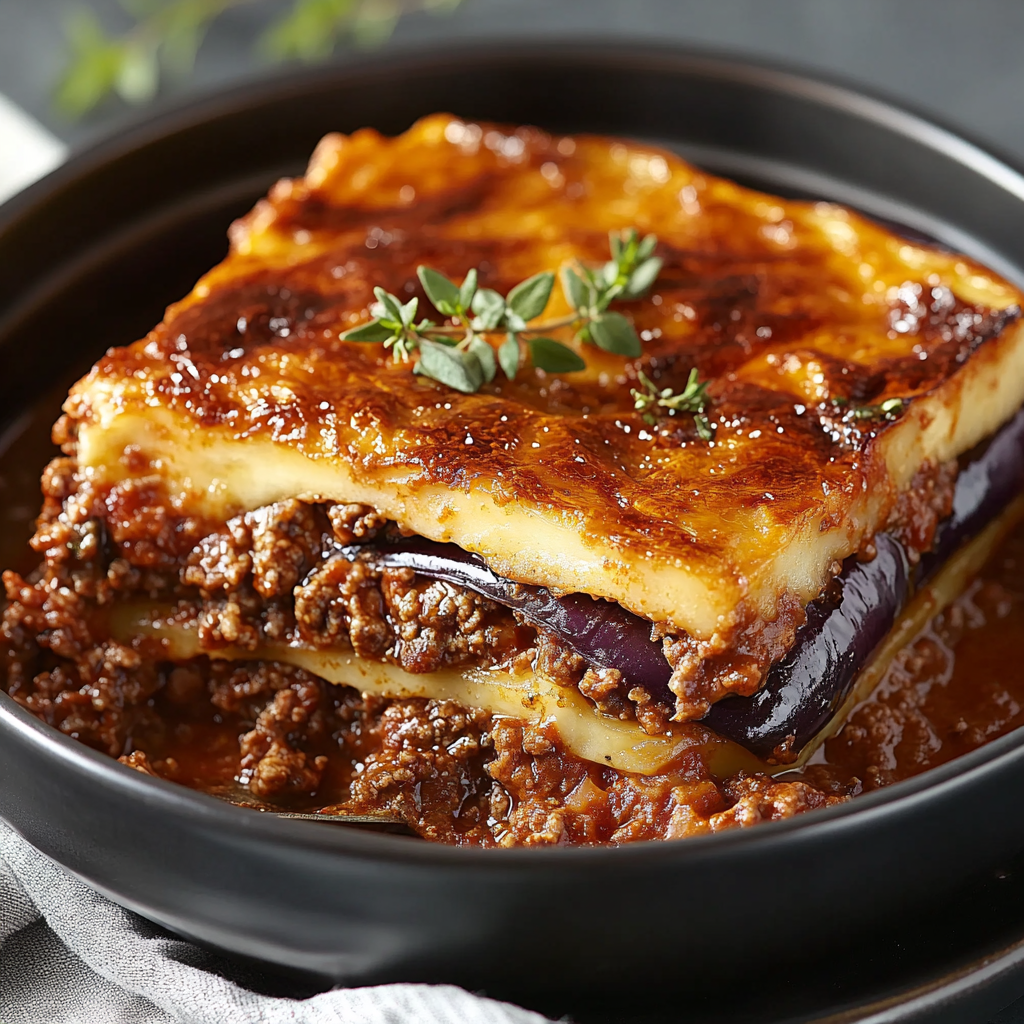Moussaka is a beloved Greek dish that embodies the essence of Mediterranean comfort food. This hearty casserole features layers of tender eggplant, spiced ground meat, and a rich béchamel sauce, all baked to golden perfection. Each bite offers a harmonious blend of flavors and textures that transport you straight to the sun-soaked shores of Greece.
Perfect for family gatherings or special occasions, this moussaka recipe is sure to impress your guests and satisfy your cravings for authentic Greek cuisine. Its comforting nature and bold flavors make it a timeless favorite that’s both nourishing and indulgent.
Full Recipe
Ingredients:
-
3 medium eggplants, sliced into 1/4-inch rounds
-
2 tablespoons olive oil
-
1 large onion, finely chopped
-
4 garlic cloves, minced
-
700g (24.7 oz) ground beef
-
2 tablespoons tomato paste
-
260g (9.2 oz) tomato sauce
-
240ml (1 cup) beef broth or 120ml (1/2 cup) red wine
-
1 bay leaf
-
1 teaspoon salt
-
½ teaspoon black pepper
-
½ teaspoon ground cinnamon
-
1 teaspoon dried thyme
-
1 liter (4.2 cups) whole milk
-
120g (4.23 oz) butter
-
120g (4.23 oz) all-purpose flour
-
85g (3 oz) grated Parmesan cheese
-
½ teaspoon ground nutmeg
-
2 large egg yolks
-
Vegetable oil for frying
Directions:
-
Prepare the Eggplants:
Slice the eggplants into 1/4-inch rounds. Sprinkle with salt and let them sit for about 30 minutes to draw out moisture and bitterness. Pat dry with paper towels. -
Cook the Meat Sauce:
In a large skillet, heat olive oil over medium heat. Add chopped onions and sauté until soft and translucent. Add minced garlic and cook until fragrant. Add ground beef, breaking it up with a spoon, and cook until browned. Stir in tomato paste, tomato sauce, beef broth (or red wine), bay leaf, salt, black pepper, cinnamon, and thyme. Simmer on low heat for 10 minutes to allow flavors to meld. -
Prepare the Béchamel Sauce:
In a saucepan, melt butter over medium heat. Whisk in flour and cook until golden brown. Gradually add milk while whisking continuously to avoid lumps. Cook until the sauce thickens. Remove from heat and stir in grated Parmesan cheese, ground nutmeg, and egg yolks until smooth. -
Fry the Eggplant Slices:
Heat vegetable oil in a frying pan over medium heat. Fry eggplant slices in batches until golden brown on both sides. Drain on paper towels to remove excess oil. -
Assemble the Moussaka:
Preheat oven to 350°F (175°C). In a baking dish, layer half of the fried eggplant slices. Spread the meat sauce evenly over the eggplant. Top with the remaining eggplant slices. Pour the béchamel sauce over the top, spreading it evenly to cover. -
Bake:
Bake in the preheated oven for 45 minutes, or until the top is golden brown and bubbly. Let it cool slightly before serving.
Prep Time: 30 minutes
Cooking Time: 2 hours
Total Time: 2 hours 30 minutes
Kcal: Approximately 516 kcal per serving
Servings: 8 servings
The Heart of Greek Comfort Food: Moussaka
Greek moussaka is one of the most iconic and beloved dishes of the Mediterranean, offering a rich blend of flavors, textures, and cultural history in every bite. Known for its hearty layers of eggplant, savory meat sauce, and creamy béchamel topping, moussaka is a quintessential comfort food that has stood the test of time. It is a dish that tells the story of Greek culinary tradition, celebrating locally sourced ingredients and the importance of family meals shared around the table.
Origins and Cultural Significance
The roots of moussaka trace back to the Levantine region, with early versions appearing in Middle Eastern and Balkan cuisines. However, the modern Greek version, which includes a luxurious béchamel sauce, was standardized in the early 20th century by the influential Greek chef Nikolaos Tselementes. His French culinary training influenced the addition of the creamy béchamel layer, transforming moussaka into the dish we recognize today.
In Greece, moussaka is more than just food—it’s a symbol of home, hospitality, and celebration. It’s commonly prepared for Sunday lunches, holidays, and festive gatherings. Each family might have its own variation of the dish, passed down through generations, with minor tweaks to suit personal preferences or regional influences.
A Perfect Balance of Texture and Flavor
What makes moussaka so special is its perfect layering of contrasting textures and complementary flavors. The base layer typically features fried or baked eggplant slices, which are soft and slightly smoky. This is followed by a hearty layer of minced meat sauce, often made from ground beef or lamb, seasoned with onions, garlic, cinnamon, and herbs. The dish is crowned with a thick, velvety béchamel sauce made from milk, butter, and flour, enriched with cheese and eggs for an irresistibly creamy finish.
The baking process allows all the layers to meld together, with the béchamel forming a golden crust that locks in moisture and flavor. The result is a dish that’s rich and indulgent, yet surprisingly balanced thanks to the freshness of the eggplant and the spices in the meat sauce.
Why It’s a Timeless Classic
Greek moussaka has retained its popularity not only because of its deliciousness but also due to its adaptability and nutritional value. Despite being a comfort food, it’s a wholesome dish packed with vegetables, protein, and dairy. It can be customized to suit dietary restrictions—vegetarians often replace the meat with lentils or mushrooms, and dairy-free béchamel sauces can be made using plant-based alternatives.
It also serves beautifully as leftovers, often tasting even better the next day as the flavors have more time to develop. In fact, many Greek families intentionally make a larger batch so they can enjoy it across multiple meals.
Tips for Making the Perfect Moussaka
To make the best moussaka, choosing the right ingredients is key. Eggplants should be firm and ripe, with minimal seeds. Salting them before cooking helps to remove any bitterness and prevents them from becoming too oily. The meat sauce should simmer long enough to develop deep flavor, and the béchamel should be smooth, thick, and well-seasoned.
Another tip is to let the moussaka rest after baking. While it’s tempting to dive in immediately, letting it sit for 15–20 minutes helps it firm up, making it easier to slice and enhancing the overall texture.
Variations Around the World
Though Greek moussaka is the most famous version, there are many regional adaptations throughout the Mediterranean and Middle East. In Turkey, a dish called “musakka” is made with sautéed eggplant, tomatoes, and minced meat, typically without the béchamel sauce. In the Balkans, potatoes are often used in place of or alongside eggplant, and some versions skip the béchamel altogether.
These regional differences highlight how versatile and beloved this dish is across cultures, each adapting it to local ingredients and traditions while maintaining the essence of what makes moussaka special.
Pairing Suggestions
Moussaka is quite filling on its own, but it pairs beautifully with a variety of sides. A crisp green salad with a lemony vinaigrette balances the richness of the dish. A glass of red wine, particularly a Greek red like Agiorgitiko, complements the savory depth of the meat sauce. For a lighter pairing, a chilled glass of retsina or ouzo adds a unique Greek touch.
Bread is also a welcome addition—either a slice of crusty sourdough or warm pita bread can be used to scoop up the sauce and béchamel. If you’re serving it for a larger meal, consider beginning with a mezze platter featuring hummus, olives, and dolmades.
Health and Nutritional Benefits
While moussaka may seem indulgent, it can be part of a healthy diet when made thoughtfully. Eggplants are high in fiber and antioxidants, and the protein from the meat makes it a satisfying main dish. By baking the eggplant instead of frying and using lower-fat milk in the béchamel, the calorie count can be reduced without sacrificing flavor.
Additionally, using lean ground meat or even substituting with legumes or plant-based meat alternatives can make the dish more heart-healthy. The key is moderation and balance, which are also central principles of the Mediterranean diet.
Storage and Reheating
One of the great advantages of moussaka is how well it stores. It can be kept in the refrigerator for up to 4 days, and it also freezes wonderfully for up to 2 months. When reheating, it’s best to use the oven to preserve the texture of the layers, especially the béchamel topping. Simply cover with foil and warm in a preheated oven at 350°F (175°C) until heated through.
Freezing individual portions makes it easy to enjoy homemade moussaka on busy weekdays—just thaw and reheat for a quick, satisfying meal.
Conclusion
Greek moussaka is more than just a casserole—it’s a celebration of culinary heritage, tradition, and the joy of shared meals. With its harmonious layers of tender eggplant, flavorful meat, and luscious béchamel, it’s a dish that appeals to all the senses. Whether you’re making it for a family gathering, a special occasion, or simply because you’re craving something comforting, moussaka delivers every time.
What makes this dish truly remarkable is its ability to adapt, inspire, and connect people. From its historical roots to its modern adaptations, moussaka has earned its place on the world stage as a dish that represents the best of Greek cooking. Serve it with love, and you’ll understand why it continues to be a favorite in kitchens across the globe.






